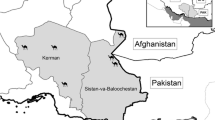Abstract
Sub-periodic form of Wuchereria bancrofti occurs in several well-isolated islands of Nicobar group of islands of Andaman Nicobar archipelago, India, presenting an interesting situation to study the genetic variability of its population. Microfilariae collected from 40 microfilaria (mf) carriers residing in eight locations on five islands (five carriers from each locality) were studied for genetic variability by generating random-amplified polymorphic DNA profiles. Phylognetic analysis of the profiles revealed a considerable genetic variability among parasite populations of different islands. The Nei’s gene diversity between populations of 40 individual mf carriers ranged from 0.0218 to 0.2400. It was highest (0.24) among the parasite populations of Car Nicobar island and lowest (0.0218) among those of Payuha area of Camorta island and Teressa island. The dendrogram constructed exhibited four distinct clusters, which are geographically localized, and the gene flow between them appears to be influenced by human migration pattern.





Similar content being viewed by others
References
Anderson TJC, Blouin MS, Beech RN (1998) Population biology of parasitic nematodes; application of genetic markers. Adv Parasitol 41:219–283
Basu PC (1958) A note on malaria and filariasis in Andaman and Nicobar. Bull Natl Soc India Malar Mosq Dis 6:193
Bisht R, Hoti SL, Thangadurai R, Das PK (2006) Isolation of Wuchereria bancrofti microfilariae from archived stained blood slides for use in genetic studies and amplification of parasite and endosymbiont genes. Acta Tropica 99:1–5
Das PK, Pani SP (2002) Prospects of elimination of lymphatic filariasis. ICMR Bulletin 32:41–54
Hoti SL, Subramaniyan K, Das PK (2003) Detection of codon for amino acid 200 in isotype 1 beta-tubulin gene of Wuchereria bancrofti isolates, implicated in resistance to benzimidazoles in other nematodes. Acta Tropica 88:77–81
Kalra NL (1974) Filariasis among aborigines of Andaman and Nicobar islands. J Commun Dis 6:40–56
Mattiucci S, Nascetti G, Cianchi R, Paggi L, Arduino P, Margolis L, Brattey J, Webb S, D’amelio S, Orecchia P, Bullini L (1997) Genetic and ecological data on the Anisakis simplex complex with evidence for a new species (Nematoda, Ascaridoidea, Anisakidae). J Parasitol 83:401–416
McDermott JM, McDonald BA (1993) Gen flow in plants pathosystems. Ann Rev Phytopathol 31:353–373
Nei M (1978) Analysis of gene diversity in subdivided populations. Proc Natl Acad Sci USA 70:3321–3323
Nie M (1987) Molecular evolutionary genetics. Columbia University Press, New York
Pani SP, Balakrishnan N, Srividya A, Bundy DA, Grenfell BT (1991) Clinical epidemiology of bancroftian filariasis: effect of age and gender. Trans R Soc Trop Med Hyg 85:260–264
Piessens WF, McReynolds LA, Williams SA (1987) Highly repeated DNA sequences as species-specific probes for Brugia. Parasitology Today 3:378–379
Pradeep Kumar N, Patra KP, Hoti SL, Das PK (2002) Genetic variability of the human filarial parasite, Wuchereria bancrofti in South India. Acta Tropica 82:67–76
Russel S, Das M, Rao CK (1975) Filariasis in Andaman and Nicobar Islands I. Survey findings—Nancowry, Teressa, Chowra, Car Nicobar and Port Blair. J Commun Dis 7:15–30
Sasa M (1976) Human filariasis—a global survey of epidemiology and control. University of Tokyo Press, Tokyo, p 334
Shriram AN, Ramaiah KD, Krishnamoorthy K, Sehgal SC (2005) Diurnal pattern of human-biting activity and transmission of subperiodic Wuchereria bancrofti (Filariidea: Dipetalonematidae) by Ochlerotatus niveus (Diptera: Culicidae) on the Andaman and Nicobar islands of India. Am J Trop Med Hyg 72:273–277
Tewari SC, Hiriyan J, Reuban R (1995) Epidemiology of sub periodic Wuchereria bancrofti infections in the Nicobar islands, India. Trans R Soc Trop Med Hyg 89:163–166
Thangadurai R, Hoti SL, Pradeep Kumar N, Das PK (2006) Phylogeography of human lymphatic filarial parasite, Wuchereria bancrofti in India. Acta Tropica 98:297–304
Yeh FC, Yang R (1999) PopGene v. 1.31, Microsoft Window-based freeware for population genetic analysis
Acknowledgment
One of the authors (R.D.) is a recipient of Junior Research Fellowship from Council of Scientific and Industrial Research (CSIR, New Delhi). Authors are thankful to Dr. P. Vanamail, VCRC, for his help in statistical analysis and Mr. K. Harikishan Raju for his help in preparation of the map of study areas. Also, thanks are due to Dr Francis, University of Alberta, for providing the freeware, ‘PopGene 32’, used for analysis of data in the present study.
Author information
Authors and Affiliations
Corresponding author
Rights and permissions
About this article
Cite this article
Dhamodharan, R., Das, M.K., Hoti, S.L. et al. Genetic variability of diurnally sub-periodic Wuchereria bancrofti in Nicobarese tribe of Nicobar group of Islands, Andaman and Nicobar Islands, India. Parasitol Res 103, 59–66 (2008). https://doi.org/10.1007/s00436-008-0927-2
Received:
Accepted:
Published:
Issue Date:
DOI: https://doi.org/10.1007/s00436-008-0927-2




